#2005 chinese gp
Text

Nico Rosberg during the 2005 Chinese Grand Prix
#dude i think i actually screamed when he popped up LMAO#its funny bcs they've namedropped him a few times throughout this season#calling him names such as 'baby rosberg' 'little nico rosberg' etc#but hes never actually been shown on camera#so him suddenly popping up??? and also the commentators didnt even acknowledge it :(#but i was like OH??????? NICO?????? IS THAT BABY NICO ROSBERG I SPOT??????#looking beauteous as always#2005 chinese gp#nico rosberg#f1#formula 1#formula one#nr6
335 notes
·
View notes
Text



Shanghai 2005: Vale flirting with the camera.
67 notes
·
View notes
Text


besos
fernando alonso | 1st place | China 2005 | podium no.23
#formula 1#f1#fernando alonso#renault#blue nando#flavio briatore#china 2005#chinese gp 2005#nando podiums
82 notes
·
View notes
Photo

2005 CHINESE GRAND PRIX
by Sutton Images
#ted kravitz#f1#chinese gp 2005#hot ted propaganda#dipped my toe back into editing for this because good lord
13 notes
·
View notes
Text
The Schumacher Dragon: Michael
In August 2009, when Michael was working towards a comeback, it was reported in a Chinese newspaper that he had ordered 3 "Chinese style" helmets. The article reported that Michael had said, "When I first went to China, a newspaper drew a dragon as my symbol." Later that year, he also spoke about this helmet in the lead up to ROC, which was held in Beijing that year.
However, the first glimpse of the dragon logo appears to have been in July 2004. At the German GP, Michael was seen with a temporary tattoo on his right forearm with the logo.
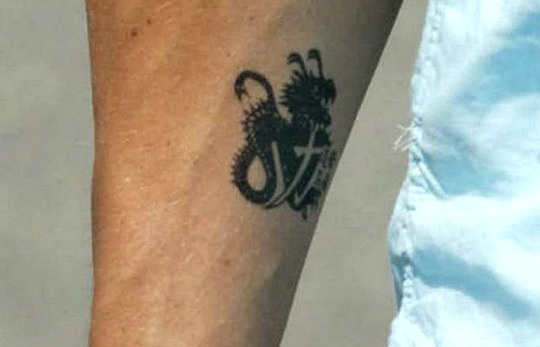

He would win the 2004 WDC two races later, at Spa. Following that at the Italian GP in Monza, the dragon would appear as a logo for the first time, on the back of his baseball cap.

The week after that marked the occasion of the first Chinese GP in Shanghai. It was here that the dragon logo would appear on his helmet for the first time. It appeared on the top of the helmet, temporarily replacing his seven stars, as well as on either side of the helmet.
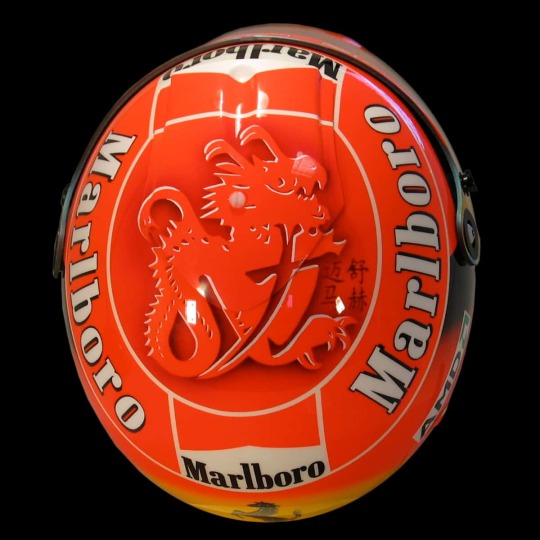
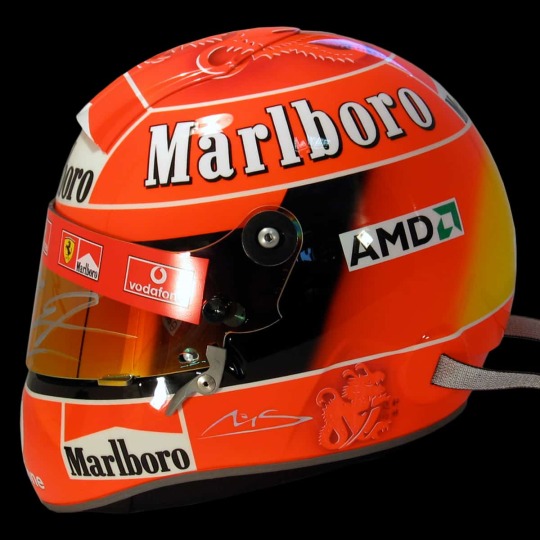

This initial iteration of the dragon logo had, in addition to the large “力”, the character for “strength”, it also includes four characters - "迈舒马赫", which roughly translates to "Mike Schumacher". This would later be removed.
The dragon would not be seen on his helmet throughout 2005, but Michael continued using it on his personal merchandise. It featured both on the back of his cap, and also on his drivers shoes.
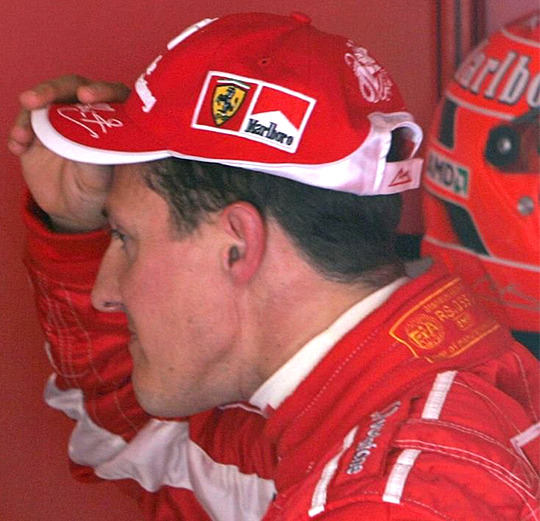
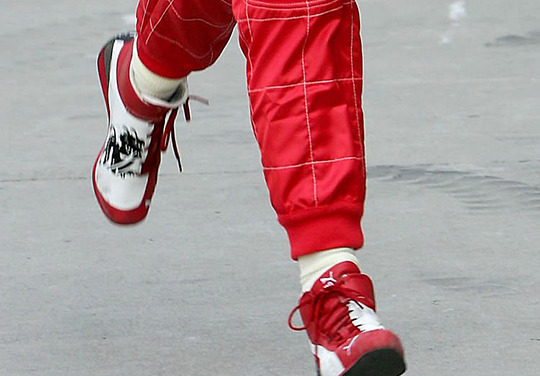
This continued into 2006, where it again featured on his caps.

However, Michael also opted to subtly incorporate the dragon back into his helmet design for 2006. This new design featured two large dragons, as well as the names of his family in Chinese (Mick “米克” and Michael “米克尔” on the right, and Gina “吉娜” and Corinna “科琳娜” on the left).

A special version of this helmet was commissioned for his final race for Ferrari, and to mark his first retirement, this time with the dragon and his family’s names featured in gold. It also included a list of his race victories around the top of the helmet.
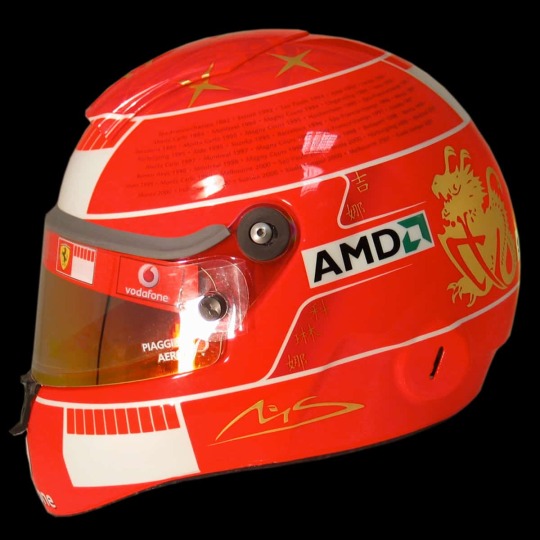
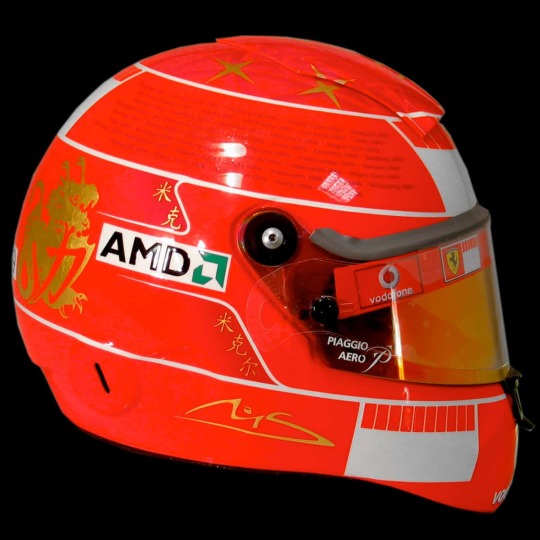
During his retirement in 2007-2008, Michael was still frequently seen around the track in his new capacity as an adviser to Ferrari. He continued featuring the dragon as part of his personal branding.
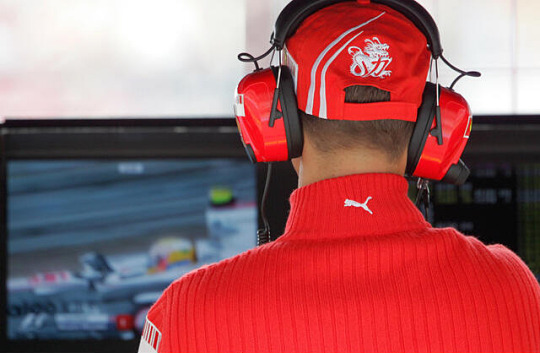
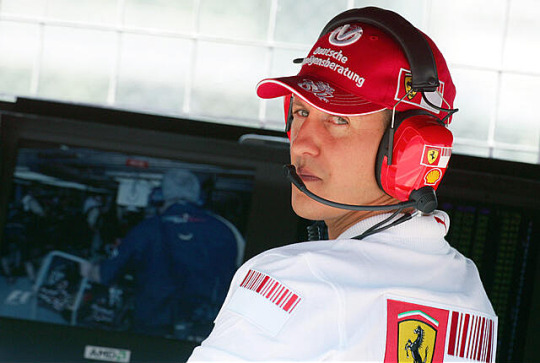
Michael also tested for Ferrari during both seasons to help with development. During at least one of these testing sessions, Ferrari had it placed on the engine cover.

As mentioned earlier, Michael was planning a return to F1 in 2009 to replace the injured Felipe Massa, though that was ultimately called off due to a neck injury suffered earlier that year. However, pictures from when he was karting in August 2009 showed the “Chinese style” helmet he had planned to use. It was very similar to the helmet design he last used in 2006, but with details in white instead.
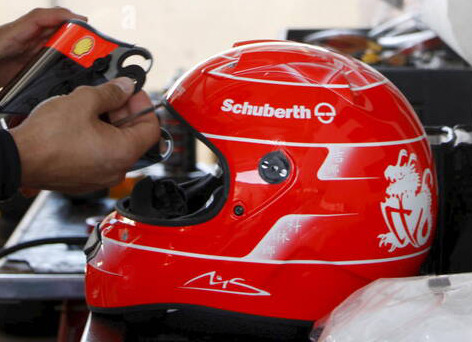
Michael made a return to F1 with Mercedes, driving with them from 2010 to 2012. He used pretty much the same helmet design throughout this time, with 2010 featuring the more subtle red version of the helmet:
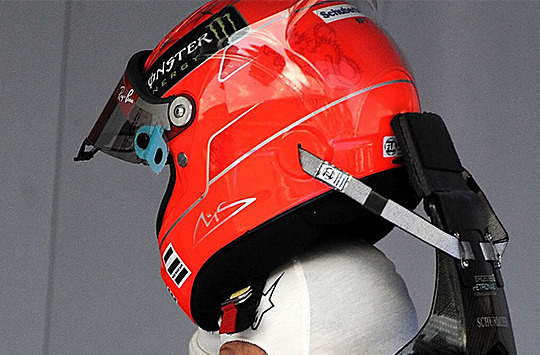
And 2011 featuring more or less the same design in silver:

2011 was also Michael’s 20th year in F1. For this, a specially designed gold-plated helmet was commissioned and used at the Belgian GP.
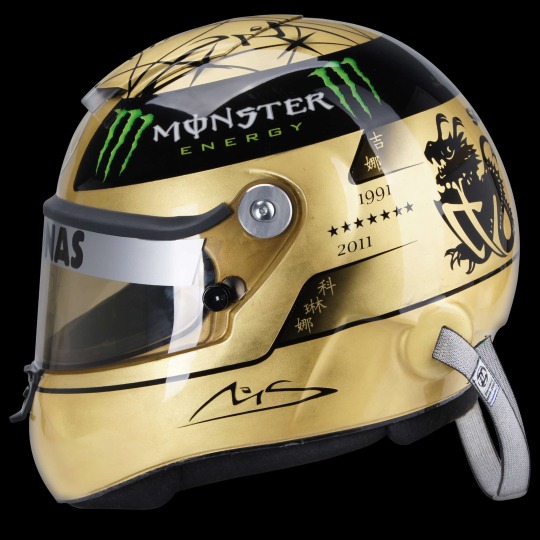

He returned to the silver dragon for the rest of his time in F1, with the exception of one more custom helmet made to commemorate his 300th F1 race at the Belgian GP in 2012:

Michael also continued to feature the dragon on both his shoes and gloves, seen here in 2010 and 2011:

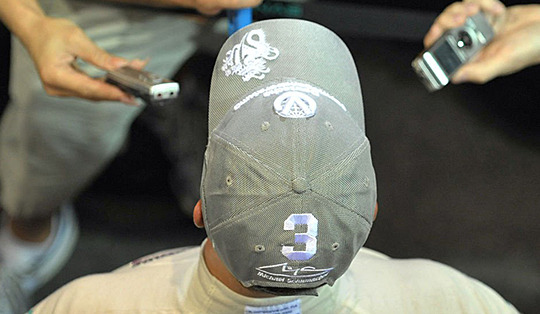

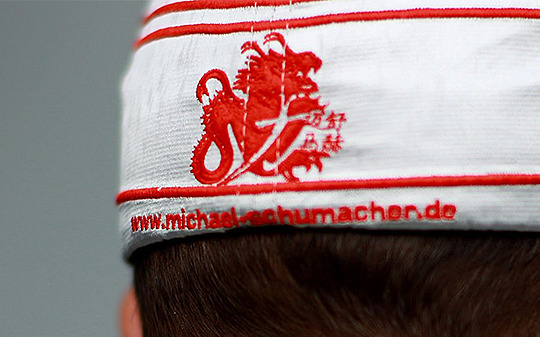
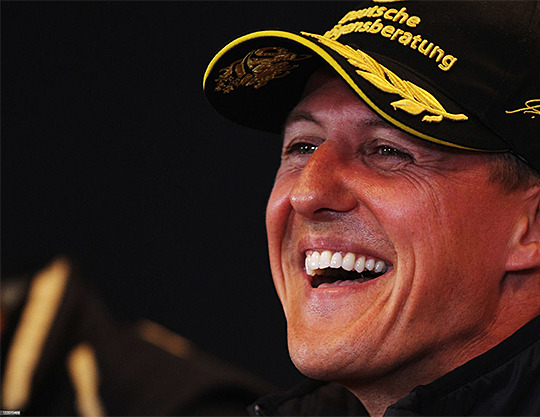
You’ll notice that for a brief period of time, Michael went back to the original iteration of the logo featuring the additional four Chinese characters, "迈舒马赫", translating to his name.
Although Michael retired at the end of the 2012 season, that was not yet the end of the dragon in motorsport. Michael used it one last time on his race suit at the Race of Champions in 2012, which he and Sebastian Vettel won for Team Germany.

Apparently a post is limited to 30 images, so on to Part 2: Mick!
Part 1: Michael | Part 2: Mick
18 notes
·
View notes
Text
IN NUMBERS: The amazing stats behind Red Bulls century of F1 wins
Red Bull made history at the Canadian Grand Prix as Max Verstappen’s dominant win gave the team their 100th victory in the sport. To mark the occasion, we put together a list of the standout numbers from their impressive run, covering drivers, circuits and other eye-catching statistics…
-- 19 --
Red Bull’s 100 race wins to date have been achieved across 19 seasons, with the Milton Keynes team making their F1 debut back in 2005. After several podium finishes, they won for the first time at the 2009 Chinese Grand Prix.
READ MORE: Verstappen wins Canadian GP to claim Red Bull’s 100th victory and equal Senna’s tally
-- 30 --
From that aforementioned first win to their most recent in Canada last weekend, Red Bull have triumphed at 30 different circuits over the years – spanning five continents (Asia, North America, South America, Europe and Oceania).
-- 7 --
Monaco is Red Bull’s most successful circuit thanks to a tally of seven victories, while Abu Dhabi’s Yas Marina (six) and Japan’s Suzuka, Belgium’s Spa-Francorchamps, Malaysia’s Sepang, Brazil’s Interlagos and Spain’s Barcelona (all five) are also particularly profitable venues for the outfit.
This feature is currently not available because you need to provide consent to functional cookies. Please update your cookie preferences
Red Bull celebrate 100th F1 win with Verstappen victory in Canada
-- 41 --
Of Red Bull’s victories so far, 41 of them have been achieved by reigning double world champion Verstappen. He started that list by winning on his debut for the team at the 2016 Spanish Grand Prix.
-- 38 --
Next in the table is Sebastian Vettel, who claimed 38 race wins – and four world titles – during his stint at Red Bull from 2009 through 2014, before leaving for Ferrari and later joining Aston Martin.
READ MORE: Verstappen hails ‘incredible’ milestone as he helps Red Bull hit a century of F1 wins
-- 5 --
Overall, five drivers have won races with Red Bull since their debut: the aforementioned Verstappen and Vettel, along with Mark Webber (nine wins) Daniel Ricciardo (seven) and current driver Sergio Perez (five).
-- 52 --
More than half of Red Bull’s victories – more specifically, 52 – have come from pole position. However, the squad have won a race from as low as 14th on the grid – Verstappen turning this spot into the top step of the podium in Belgium in 2022.
It was a momentous day for Verstappen and Red Bull in Canada
-- 26 --
Meanwhile, more than a quarter of Red Bull’s victories have spearheaded a one-two finish. The first of these 26 perfect results came in China in 2009 via Vettel and Webber, with the most recent coming in Miami in 2023 via Verstappen and Perez.
-- 17 --
Red Bull’s most successful season in terms of race wins was the 2022 campaign, in which they triumphed 17 times. Verstappen took 15 of those victories, while Perez contributed two.
FACTS AND STATS: Red Bull match Mercedes’ best-ever season start as Hamilton takes 10th Montreal podium
-- 4 --
Only four other teams have secured more than 100 wins in the history of F1. This group comprises Williams (114), Mercedes (125), McLaren (183) and Ferrari (242).
-- 9 --
If Red Bull win again at the upcoming Austrian Grand Prix, the team would take 10 victories in a row for the first time. They previously won nine on the bounce with Vettel during the second half of his final title-winning season in 2013.
via Formula 1 News https://www.formula1.com
2 notes
·
View notes
Text
中国の気球
F-22 が空対空ミサイルで撃墜するという凄い結末になった。機関砲で十分じゃない? と思ったが、遠くから撃てて勝手に標的に向かってくれるのでミサイルの方が楽か。
2020年に宮城県に飛来した気球と装置部分の形が微妙に違うが、巨大な太陽電池パネルを積んでいるという異常な特徴が同じなので、出所は同じだろうと個人的には思う。

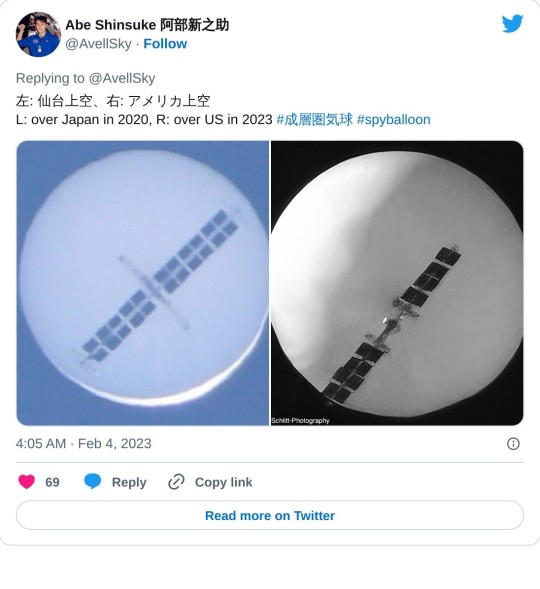
クローズアップ画像も出ている。超望遠撮影で圧縮効果が働いているので、バルーンと装置部の大きさの比率はほぼこのままと思ってよいだろう。
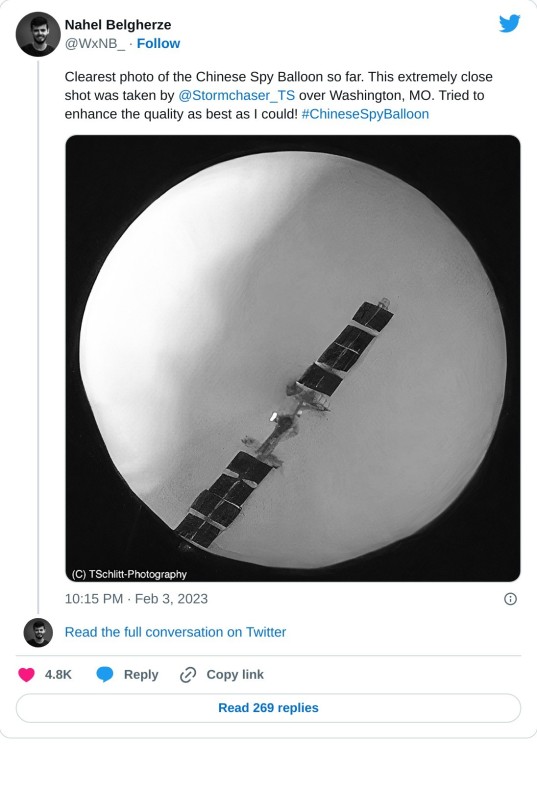
米軍の発表ではバルーンの直径は90ft (27m) とのこと。だとすると、太陽電池パネルは目分量で、8m×2m が2枚といったところか。「はやぶさ2」の太陽電池パネルがおよそ 6m×2m×2枚なので、はやぶさ2と同じかそれ以上の図体である。
一般に、太陽電池パネルの単位面積当たりの発生電力はざっくり150W/m^2 くらいとのこと。なので、この気球では約2400Wもの電力を必要としていることになる。
中国政府は民間による気象観測などの研究用気球だと説明しているが、ただの科学観測用気球で2400Wもの電力はどう考えても不要。気象庁など世界の気象観測機関が12時間ごとに「ラジオゾンデ」という気球を揚げて高層大気の観測をしているが、これは電力をCR-123などの小型リチウム電池で供給している。各種センサーの動作と無線通信だけなのだからそんなものだろう。数時間で約30kmまで上昇した後、破裂して地上に落ちてくる。
特集:気象予測の現在 2005年6月号 ナショナルジオグラフィック NATIONAL GEOGRAPHIC.JP
気象庁 | ラジオゾンデによる高層気象観測
GPSラジオゾンデ iMS-100|明星電気株式会社
というわけで、2kWを超えるほどの大電力が受動的な観測気球で必要だというのはきわめて不自然。動力飛行のためのプロペラなどの推進系や、動画などの高度な撮影機器を積んでいるためだと考えるのが自然だろう。
0 notes
Photo

9 notes
·
View notes
Text
The Turkish GP is the 11th GP to not have ANY DNFs and it’s the second this year.
1961 Dutch GP
2005 Italian GP
2005 US GP
2011 European GP
2015 Japanese GP
2016 Chinese GP
2016 Japanese GP
2018 Chinese GP
2019 Austrian GP
2021 French GP
46 notes
·
View notes
Text
I feel like this clip from the podium deserves to be posted in full
#THEY'RE SO CUTEEEEEEEEEE I CANT I CANT#NANDO IS HIS BOY THATS LITERALLY HIS BOY!!!!#LOOK AT THEM LOOK AT THEM!!!#ive seen some pics from this podium i think but nothing can live up to the full clip in entirety#like theres just so many things that make me wanna sob and yell into my pillow#tho actually it did in fact make me legit squeal and roll around on my bed when i first watched it#them!!!! them!!!!!!!!!! <33333#the way he keeps indulging nando and the way theyre so affectionate its really just unbearably adorable to me#fernando alonso#fa14#flavio briatore#2005 chinese gp#2005 chinese grand prix#f1#formula 1#formula one#we do a little bit of f1#no sound sry lol but i dont think it wouldve added anything anyways so its okie!#also kinda wanna make a comp of pictures from this race maybe??? theres just so many cute moments w renault so yeah might make that soon#ralf schumacher#kimi räikkönen#kimi raikkonen
178 notes
·
View notes
Text
The History of the Mercedes F1 Team
I was inspired by the videos Sky showed during testing of the histories of Aston Martin and Alpine during testing so I thought I would do Mercedes, as this team has one of the weirder histories in F1, bear in mind I have just used the results from the train from Tyrell down to the present-day Mercedes team - so the two championships the original Mercedes team have aren’t included

Constructors Championships: 9
(1971, 2009, 2014, 2015, 2016, 2017, 2018, 2019, 2020)
Drivers Championships: 11
(1969, 1971, 1973, 2009, 2014, 2015, 2016, 2017, 2018, 2019, 2020) Jackie Stewart (3), Jenson Button (1), Lewis Hamilton (7), Nico Rosberg (1)
Race victories: 148
Pole positions: 147
Fastest laps: 109
Tyrell Racing
(1968 - 1998)
First entry: 1968 South African Grand Prix
Races entered: 465 entries (463 starts)
Constructors Championships: 1 (1971)
Drivers Championships: 3 (1969, 1971, 1973) - Jackie Stewart
Race victories: 33
Pole positions: 19
Fastest laps: 27
Final entry: 1998 Japanese Grand Prix
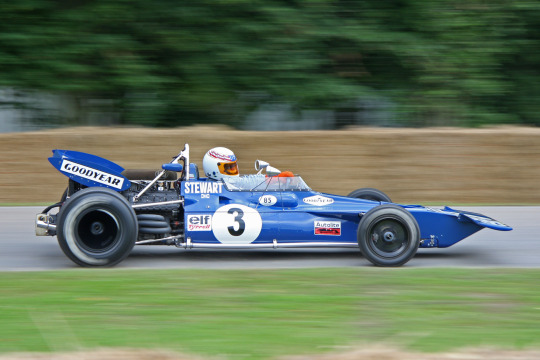

Eventually, in 1998 and in the face of dwindling form and ill health, Ken Tyrell sold his team to British American Tobacco, the team becoming British American Racing.
British American Racing and BAR Lucky Strike Honda
(1999 - 2005)
First entry: 1999 Australian Grand Prix
Races entered: 118 (117 starts)
Engines: Supertec, Honda
Constructors Championships: 0 (best finish; 2nd 2004)
Drivers Championships: 0
Race victories: 0
Podiums:15
Points: 227
Pole positions: 2
Fastest laps: 0
Final entry: 2005 Chinese Grand Prix
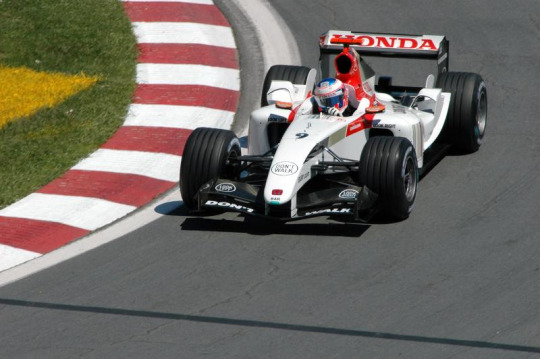

At the end of 2005, Honda obtained 100% ownership of BAR from British American Tobacco, completing their ambition to become a full F1 manufacturer team. In addition, Jenson Button's Williams contract was bought out for US$30 million, and Button signed a multi-year contract with Honda.
Honda Racing F1 Team
(2006 - 2008)
First entry: 2006 Bahrain Grand Prix
Races entered: 43
Engines: Honda
Constructors Championships: 0
Drivers Championships: 0
Race victories: 1
Podiums: 4
Points: 106
Pole positions: 1
Fastest laps: 0
Final entry: 2008 Brazilian Grand Prix


Honda suddenly exited the sport at the end of the 2008 season, unwilling to continue the Brackley-based team's $300 million budget and staff of 700 during the global economic crisis.
The team continued to work on the Honda RA109 for the 2009 season while Honda attempted to sell the racing team.
Ross Brawn bought the team for £1 in order to keep the team in the sport
Brawn GP Formula One Team
(2009)
First entry: 2009 Australian Grand Prix
Races entered: 17
Engines: Mercedes
Constructors Championships: 1 (2009)
Drivers Championships: 1 (2009) - Jenson Button
Race victories: 8
Podiums: 15
Points: 172
Pole positions: 5
Fastest laps: 4
Final entry: 2009 Abu Dhabi Grand Prix

On 16 November 2009 it was officially announced that Daimler AG in partnership with Aabar Investments had purchased a 75.1% stake in Brawn GP (Daimler AG: 45.1%; Aabar: 30%).
It was rumoured that the partnership paid £110m for the 75.1%. The team would be rebranded as Mercedes GP for 2010. The remaining 24.9% stake is Ross Brawn's in partnership with Nick Fry. The team used the Brawn GP base in Brackley for its operations and Brawn stayed on as team principal until the end of the 2013 season.
Mercedes-AMG Petronas Formula 1 Team
(2010 - Present)
First entry: 2010 Bahrain Grand Prix
Last entry: 2020 Abu Dhabi Grand Prix
Races entered: 227
Engines: Mercedes
Constructors Championships: 7 (2014, 2015, 2016, 2017, 2018, 2019, 2020)
Drivers Championships: 7 (2014, 2015, 2016, 2017, 2018, 2019, 2020) - Lewis Hamilton (6) Nico Rosberg (1)
Race victories: 106
Podiums: 219
Points: 5685
Pole positions: 120
Fastest laps: 78


#f1 essay#f1 history#f1#Formula 1#also it’s so crazy to think that a team with 11 drivers titles came from 4 drivers - 3 who were british#some of my favourite ever f1 cars are in this list#some fantastic liveries too
22 notes
·
View notes
Text
Artificial Intelligence: A Brief History
Ancient Greek mythology included intelligent robots and artificial entities for the first time. The creation of syllogism and its application of deductive reasoning by Aristotle was a watershed point in humanity's search to comprehend its own intelligence. Despite its long and deep roots, artificial intelligence as we know it today has only been around for a century. The following is a quick rundown of some of the most significant AI events.
1940s * "A Logical Calculus of Ideas Immanent in Nervous Activity," by Warren McCullough and Walter Pitts, is published in 1943. The first mathematical model for developing a neural network was proposed in this publication. (1949) Donald Hebb offers the hypothesis that brain pathways are formed by experiences and that connections between neurons become stronger the more they are used in his book The Organization of Behavior: A Neuropsychological Theory. In AI, Hebbian learning remains an essential model.
1950s Alan Turing publishes "Computing Machinery and Intelligence" in 1950, suggesting the Turing Test, a method for detecting whether or not a machine is intelligent. Marvin Minsky and Dean Edmonds, Harvard undergraduates, create SNARC, the first neural network computer, in 1950. Claude Shannon publishes "Programming a Computer for Playing Chess" in 1950.
*
The "Three Laws of Robotics" are published by Isaac Asimov in 1950.
*
Arthur Samuel creates a checkers self-learning software in 1952.
(1954) In the Georgetown-IBM machine translation experiment, 60 carefully selected Russian sentences are mechanically translated into English.
At the "Dartmouth Summer Research Project on Artificial Intelligence" in 1956, the term "artificial intelligence" is developed. The conference, which established the scope and goals of AI and was led by John McCarthy, is largely regarded as the genesis of artificial intelligence as we know it today.
*
Allen Newell and Herbert Simon exhibit the first reasoning program, Logic Theorist (LT), in 1956.
John McCarthy creates Lisp, an AI programming language, and publishes his article "Programs with Common Sense" in 1958. The paper proposed the Advice Taker, a complete AI system capable of learning from experience in the same way as humans do.
* In 1959, Allen Newell, Herbert Simon, and J.C. Shaw created the General Problem Solver (GPS), a computer program that mimics human problem-solving.
*
Herbert Gelernter created the Geometry Theorem Prover program in 1959.
*
While working at IBM in 1959, Arthur Samuel coined the phrase "machine learning."
The MIT Artificial Intelligence Project was started by John McCarthy and Marvin Minsky in 1959.
1960s
*
John McCarthy establishes the Stanford AI Lab in 1963.
* 1966) The Automatic Language Processing Advisory Committee (ALPAC) report by the U.S. government details the lack of progress in machine translations research, a major Cold War initiative with the promise of automatic and instantaneous translation of Russian. The ALPAC report leads to the cancellation of all government-funded MT projects.
* (1969) The first successful expert systems are developed in DENDRAL, a XX program, and MYCIN, designed to diagnose blood infections, are created at Stanford.
1970s
* (1972) The logic programming language PROLOG is created.
* 1973) The British government releases the "Lighthill Report," which details AI research failures and results in significant funding cuts for AI initiatives. (1974-1980) Dissatisfaction with AI progress leads to significant DARPA reductions in research grants. Artificial intelligence funding is drying up, and research is stagnating, according to the ALPAC study and the previous year's "Lighthill Report." The "First AI Winter" occurs during this time.
1980s
R1 (also known as XCON), the first successful commercial expert system, is developed by Digital Equipment Corporations in 1980. R1, which is designed to configure orders for new computer systems, kicks off a decade-long investment boom in expert systems, essentially ending the first "AI Winter."
*
The ambitious Fifth Generation Computer Systems project is launched by Japan's Ministry of International Trade and Industry in 1982. The purpose of FGCS is to create a platform for AI development and supercomputer-like performance.
1983) In response to Japan's FGCS, the US government develops the Strategic Computing Initiative, which will fund advanced computing and artificial intelligence research through DARPA. (1985) Companies invest over a billion dollars a year on expert systems, and an entire sector called the Lisp machine market emerges to support them. Symbolics and Lisp Machines Inc. are two companies that make customized computers that run on the AI programming language Lisp.
1987-1993) As computing technology advanced, cheaper alternatives arose, and the Lisp machine market crashed in 1987, kicking off the "Second AI Winter." Expert systems became too expensive to operate and update during this time, and they finally fell out of favor.
1990s
During the Gulf War in 1991, US forces used DART, an automated logistical planning and scheduling program.
(1992) Japan cancels the FGCS project in 1992, alleging failing to reach the grandiose targets set a decade before.
DARPA terminated the Strategic Computing Initiative in 1993, after spending over $1 billion and falling short of expectations. (1997) World chess champion Gary Kasparov is defeated by IBM's Deep Blue in the 2000s
*
(2005) The DARPA Grand Challenge is won by STANLEY, a self-driving automobile.
2005: The United States military began to invest in self-driving robots such as Boston Dynamics' "Big Dog" and iRobot's "PackBot."
*
(2008) Google develops advancements in speech recognition and makes the feature available via its iPhone app.
2010-2014
*
On Jeopardy!, IBM's Watson beats out the competition.
(2011) Apple's iOS operating system introduces Siri, an AI-powered virtual assistant.
* In 2012, Andrew Ng, the inventor of the Google Brain Deep Learning project, fed 10 million YouTube videos as a training set to a neural network using deep learning methods. The neural network learns to recognize a cat without being informed what a cat is, ushering in a new era of deep learning funding and neural networks. (2014) Google's self-driving car passes a state driving test for the first time. From 2015 through 2021, Amazon's Alexa, a virtual home, will be available.
*
(2016) World champion Go player Lee Sedol is defeated by Google DeepMind's AlphaGo. The ancient Chinese game's complexity was seen as a significant barrier to overcome in AI.
* (2016) Hanson Robotics develops Sophia, a humanoid robot capable of facial recognition, verbal conversation, and facial expression, as the world's first "robot citizen."
*
(2018) Google releases BERT, a natural language processing engine that lowers hurdles to machine learning applications' translation and interpretation.
*
(2018) Waymo announces the Waymo One service, which allows consumers in the Phoenix metro region to order a pick-up from one of the company's self-driving cars.
* (2020) Baidu makes its LinearFold AI algorithm available to scientific and medical teams working on a vaccine during the SARS-CoV-2 pandemic's early phases. The system can anticipate the virus's RNA sequence in just 27 seconds, which is 120 times faster than prior methods.
2 notes
·
View notes
Text
The Père David’s Deer Pattern
Free pattern time!!!
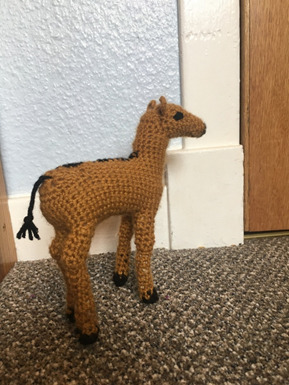

This is a Père David’s deer, an incredibly interesting animal I don’t think gets enough attention. It’s also a great example of the benefits of captive breeding! I’m hoping this post will teach you about the deer, but also about some of the benefits captive breeding programs can have! Shoot me a message if you have any questions about the pattern, the animal, or captive breeding programs!
Quick facts:
Said to look like a combination of a deer, a donkey, a cow, and a horse
Went extinct in China, only survived because a monk stole from the Chinese emperor
Weighs up to 200 kg; could (and has) beat me in a fight
Click keep reading to learn about the history of the deer and the benefits of captive breeding, or go to the bottom for the pattern (I know, it’s clunky)
The story
For a long time, Père David’s deer lived across China, but by 1860 all the remaining animals belonged to the Emperor, who kept them in a carefully guarded private garden. Breaking in was punishable by death.
A visiting French monk, Père Armand David (yeah, the same guy who told the West about pandas) somehow found out about—and then got his hands on—some of the deer. How exactly he did this is unclear, but we can say pretty definitely that they were stolen, either by evading or bribing the guards. Père David himself would probably have claimed they were a gift, which would have been a lie. At any rate, a few of the deer were smuggled back to private collections in Western Europe over the years.
In 1895, a flood knocked down part of the walls enclosing the royal garden, and some of the deer escaped, only to be eaten by starving peasants. The deer that had stayed in the garden were killed by German troops during the Boxer Rebellion soon after.
Meanwhile, the 11th Duke of Bedford had been gathering all the deer living in Europe at Woburn Abbey in England. All modern Père David’s deer are descended from 11 of the 18 animals he managed to find. Surprisingly, there don’t seem to be any problems from all this inbreeding (that we’ve noticed yet, anyway). Starting in 1985, small herds were sent back to guarded nature reserves in China, and by 2005 over 2000 Père David’s deer were living in China. A few hundred currently live in the wild—they escaped after a flood, the same way as in 1895.
The takeaway
Obviously, despite its shady beginnings, this is a success story for captive breeding and reintroduction! Today, though, breeding programs are better than they were in the 19th century. More attention is paid to inbreeding, and we tend to begin programs much earlier than we did in this case. The cooperation of international zoos would hopefully keep a population from falling as low as the Père David’s did, and modern programs keep a stud book for the entire captive species to help prevent inbreeding.
Programs also try to make sure that animals don’t lose their survival skills after a few generations in captivity. There’s evidence that moose could lose their reaction to dangerous predators after three generations in captivity! The Père David’s deer, though, still reacts well to their historical predators, such as tigers. Overall, they’ve avoided a lot of the pitfalls that captive-bred species are especially vulnerable to, and a healthy, diverse, completely wild population might be coming soon to China.






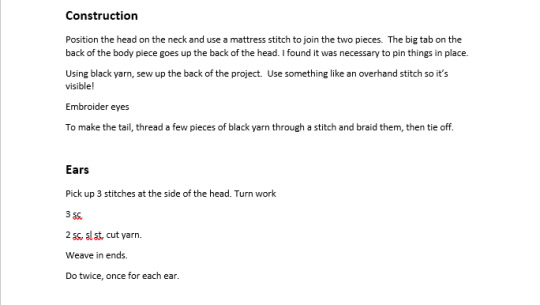
Post sources (if you’re interested)
Jiang, Z et al (2000). Reintroduction and recovery of Pere David’s deer in China. Wildlife Society Bulletin 28(3): 681-687.
Jiang, Z. & Harris, R.B. 2016. Elaphurus davidianus. The IUCN Red List of Threatened Species 2016: e.T7121A22159785.
Li C et al (2011). Do Pere David’s deer lose memories of their ancestral predators? PLoS One 6(8): e23623.
Seddon PJ et al (2014). Reversing defaunation: Restoring species in a changing world. Science 345(6195): 406-412.
Yuan B et al (2019). Differential movement pattern of Pere David’s deer associated with the temporal rhythm using GPS collar fix. Global Ecology and Conservation 18:e00641
Wakchaure R & Ganguly S (2016). Captive Breeding in Endangered Wildlife: a Review. Journal of biological and scientific opinion 4(5): 186-187.
#crochet pattern#free crochet pattern#knitblr#amigurumi#pere davids deer#milu#fiber arts#this one is actually for a class#knitting pattern
54 notes
·
View notes
Text
Singapore Won’t Be F1′s 1,000th Race
The 2019 Singapore Grand Prix won’t be classed as F1′s 1000th race, despite a strong argument being put forward for it to be.
“Everyone thinks that the 2019 Chinese Grand Prix was the sport’s millennial race, which couldn’t be further from the truth. As we all know, the 2005 US Grand Prix was disqualified from counting as an official Formula 1 event some time ago, thus moving the 1000th event to the 2019 Azerbaijan Grand Prix. Fake Real-F1-News seemed happy to settle for that, but there’s more. From 1950-1960, the Indy 500 counted as an F1 race, even though a vast majority of F1 drivers didn’t take part in that race, so we have to also discount those 11 races as well, making the REAL 1000th Grand Prix the 2019 Singapore Grand Prix. This will also mean that the 2008 Singapore Grand Prix will no longer be considered the sport’s 800th race, something we can all get behind!” claimed F1 historian Some Bloke.
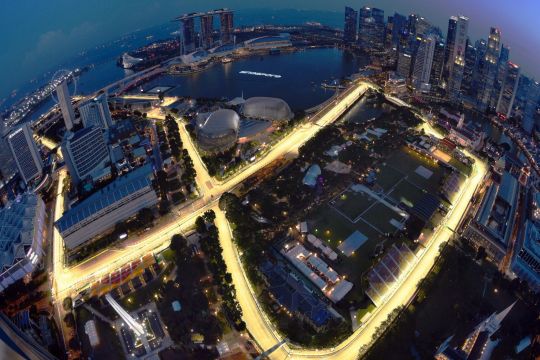
“Although this is a solid argument, we can’t simply change which race was the 1000th, just because races ran to F1 regulations from 1947 we didn’t like the one in China this year. I mean, it was completely boring, and a bigger let down than the time Letty the let down let down his only child, but that’s no reason to discount it!” stated FIA President Jean Todt, who was team principal at Ferrari during the 2005 US GP, so would also benefit from the race counting towards the total number.
6 notes
·
View notes
Text
Max Verstappen claims Canadian F1 GP pole as Pérez and Leclerc trail
Max Verstappen took pole for the Canadian Grand Prix, delivering another dominant run in difficult, changeable conditions for Red Bull. With rain very much playing its part he beat the Haas of Nico Hülkenberg into second and the Aston Martin of Fernando Alonso into third. Lewis Hamilton and George Russell were in fourth and fifth for Mercedes. Alpine’s Esteban Ocon was sixth and McLaren’s Lando Norris in seventh.
Verstappen once more had the best pace in a qualifying session that had opened shortly after rain had hit the circuit and then returned again as the session progressed. Whether he might have been challenged remains moot as the final running was scuppered by the conditions but on every lap he put in, the world champion still looked to enjoy a comfortable advantage over the rest of the field.
He goes into the race as strong favourite to score another win for Red Bull, who remain unbeaten from seven meetings this season. If the team secure victory it will be their 100th since the team entered its debut race in 2005, having taken their first at the Chinese GP in 2009.
There is a further milestone on offer for the 25-year-old who should he secure his 41st victory will match Ayrton Senna’s wins. This weekend Hamilton conceded that his record tally of 103 wins, once thought to be untouchable, was potentially reachable by Verstappen.
With the rain still peppering the circuit and growing in intensity, the final session was defined by the earliest laps in Q3. Verstappen, out first, set the benchmark on his second lap with a time of 1minute 25.858 seconds only shortly after which running was stopped when Oscar Piastri put his McLaren in the wall, a decisive moment that ended the fight for pole. When they resumed qualifying the rain had only intensified, leaving no chance to improve on the times.
Hülkenberg had already been out in a good run, second to Verstappen and it paid off, securing his second best grid position and Haas’s first front row start in a GP.
Carlos Sainz was eighth for Ferrari but is under investigation for impeding, Piastri was ninth and Alex Albon in tenth for Williams.
skip past newsletter promotion
after newsletter promotion
Quick Guide
How do I sign up for sport breaking news alerts?
Show
Download the Guardian app from the iOS App Store on iPhone or the Google Play store on Android by searching for 'The Guardian'.
If you already have the Guardian app, make sure you’re on the most recent version.
In the Guardian app, tap the Menu button at the bottom right, then go to Settings (the gear icon), then Notifications.
Turn on sport notifications.
Ferrari’s Charles Leclerc and Red Bull’s Sergio Pérez were caught out on the wrong tyres in Q2, not setting a good enough time before the rain returned and they finished in 11th and 12th respectively. Lance Stroll was 13th for Aston Martin, Kevin Magnussen in 14th for Haas and Valtteri Bottas 15th for Alfa Romeo.
Yuki Tsunoda and Nyck de Vries were in 16th and 18th for AlphaTauri and Pierre Gasly 17th for Alpine. Logan Sargeant was in 19th for Williams and Guanyu Zhou 20th for Alfa Romeo.
via Formula One | The Guardian https://www.theguardian.com/sport/formulaone
0 notes